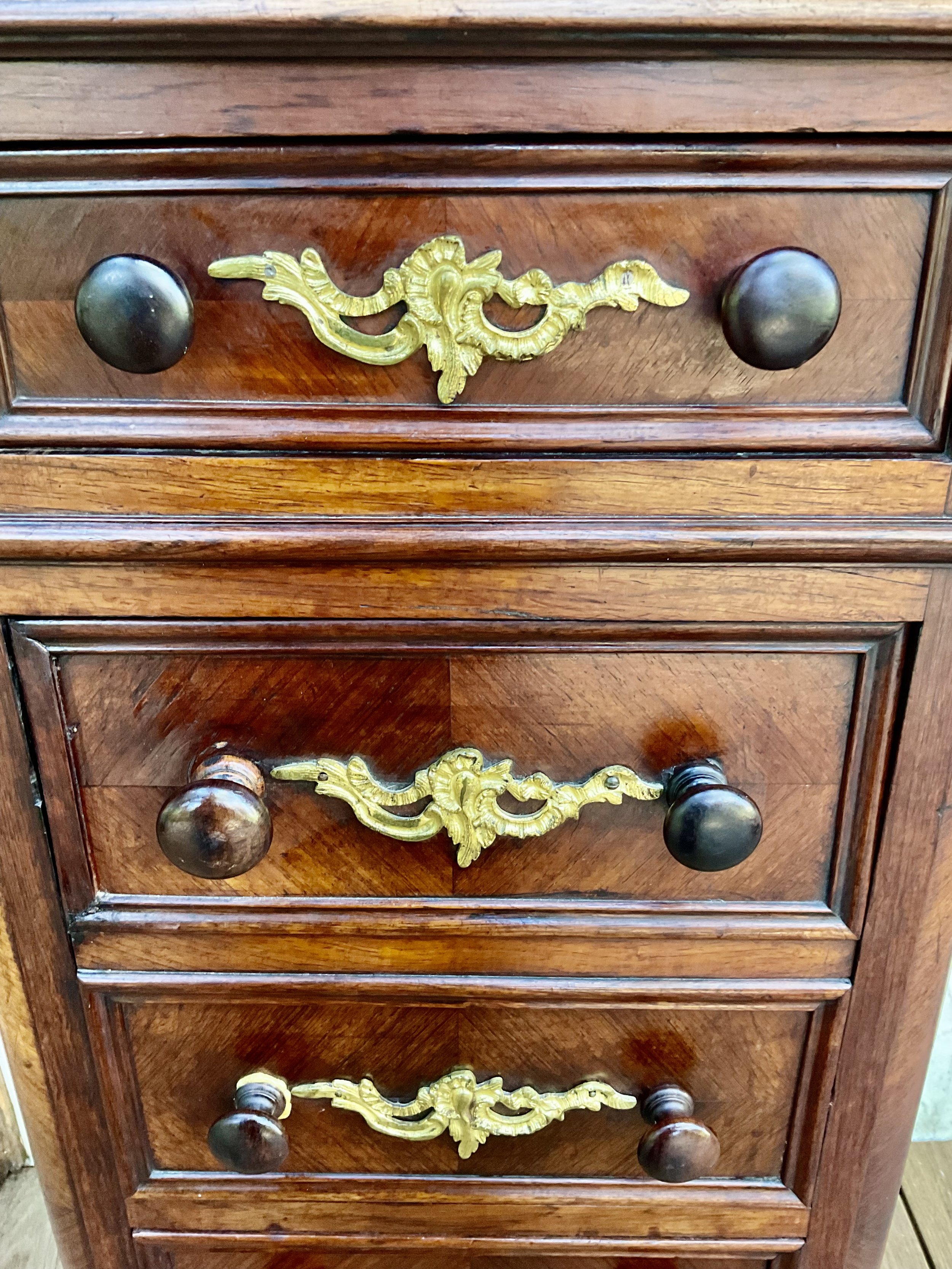 Image 1 of 7
Image 1 of 7

 Image 2 of 7
Image 2 of 7

 Image 3 of 7
Image 3 of 7

 Image 4 of 7
Image 4 of 7

 Image 5 of 7
Image 5 of 7

 Image 6 of 7
Image 6 of 7

 Image 7 of 7
Image 7 of 7








French Art Nouveau Nest Of Tables
This nest of tables is a rare find. Comprising of three small tables in graduating sizes, they fit neatly into each other. Each table top has a carved organic design, typical of the art nouveau era. These tables have been recently professionally restored.
The Art Nouveau Period (1890 – 1910) was an ornamental style of art that flourished throughout Europe, and indeed, the world. Victor Horta, a Belgian architect, is considered to be the Father of Art Nouveau. He attempted to modernise design, moving away from the historical styles that had been popular in the past. The Art Nouveau period was a reaction against academic art and the styles of decorative art prominent in the 19th century. It was used in interior design, jewellery, glass design, posters and illustration. Art Nouveau featured concepts such as long sinuous line, organic shapes such as arches and curves and natural elements such as leaves, flowers, vines, insects and animals. Major artists of this time included Gustav Klimt, Aubrey Vincent Beardsley, Henri de Toulouse-Lautrec and Alphonse Mucha. The Art Nouveau Period was most prominent in France where architecture featured high courtyards, stained glass cupolas and ceramic decoration. Some examples include the metro entrances in Paris, Maxim’s Restaurant, the interior of the Grand Palais des Champs-Elysees and the lamps od the Pont Alexandre 111.
This nest of tables is a rare find. Comprising of three small tables in graduating sizes, they fit neatly into each other. Each table top has a carved organic design, typical of the art nouveau era. These tables have been recently professionally restored.
The Art Nouveau Period (1890 – 1910) was an ornamental style of art that flourished throughout Europe, and indeed, the world. Victor Horta, a Belgian architect, is considered to be the Father of Art Nouveau. He attempted to modernise design, moving away from the historical styles that had been popular in the past. The Art Nouveau period was a reaction against academic art and the styles of decorative art prominent in the 19th century. It was used in interior design, jewellery, glass design, posters and illustration. Art Nouveau featured concepts such as long sinuous line, organic shapes such as arches and curves and natural elements such as leaves, flowers, vines, insects and animals. Major artists of this time included Gustav Klimt, Aubrey Vincent Beardsley, Henri de Toulouse-Lautrec and Alphonse Mucha. The Art Nouveau Period was most prominent in France where architecture featured high courtyards, stained glass cupolas and ceramic decoration. Some examples include the metro entrances in Paris, Maxim’s Restaurant, the interior of the Grand Palais des Champs-Elysees and the lamps od the Pont Alexandre 111.
This nest of tables is a rare find. Comprising of three small tables in graduating sizes, they fit neatly into each other. Each table top has a carved organic design, typical of the art nouveau era. These tables have been recently professionally restored.
The Art Nouveau Period (1890 – 1910) was an ornamental style of art that flourished throughout Europe, and indeed, the world. Victor Horta, a Belgian architect, is considered to be the Father of Art Nouveau. He attempted to modernise design, moving away from the historical styles that had been popular in the past. The Art Nouveau period was a reaction against academic art and the styles of decorative art prominent in the 19th century. It was used in interior design, jewellery, glass design, posters and illustration. Art Nouveau featured concepts such as long sinuous line, organic shapes such as arches and curves and natural elements such as leaves, flowers, vines, insects and animals. Major artists of this time included Gustav Klimt, Aubrey Vincent Beardsley, Henri de Toulouse-Lautrec and Alphonse Mucha. The Art Nouveau Period was most prominent in France where architecture featured high courtyards, stained glass cupolas and ceramic decoration. Some examples include the metro entrances in Paris, Maxim’s Restaurant, the interior of the Grand Palais des Champs-Elysees and the lamps od the Pont Alexandre 111.
Not suitable for delivery via Australia Post. Collection by appointment. Please make contact if you would like to arrange another type of delivery. Free delivery to some Melbourne metropolitan areas can be arranged.








